6 Ways Horses Show Their Feelings
We invite you to consider the many ways horses can show feelings of affection and happiness, both for each other and for their human friends.
How much do you know about how horses show affection? Test your knowledge of horses and their emotions with our quiz.
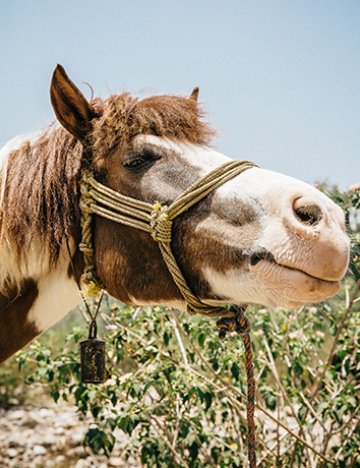
Horses often communicate their wants and needs with their eyes and ears, but when it comes to gauging their emotions sometimes you can pick up additional cues by listening as well as watching, as their snorts and whinnies will tell you a lot about how they are feeling.
Snorts
A snort can be a good sign that a horse is happy or feels at peace. And the more they snort, along with other positive visual indicators, the more they are likely to be feeling calm and comfortable.
A study from 2018 backs up this theory - scientists at the University of Rennes in France studied three groups of horses placed in different settings - two that spent most of their time in blocks and pastures and one that freely roamed about in open pasture. They observed that the horses snorted when they were in a positive situation (i.e. a pasture), and the two groups of horses that were in stalls snorted twice as much when they were let outside. When they were placed in a pasture with a new food source they snorted up to 10 times more!
A snort can sometimes indicate stress however, so it's best to take note of both visual and acoustic clues to get the full picture of the horse's feelings.
Whinnies
Whinnies can also convey both positive and negative emotions. Scientists in a different study found that there are two frequencies to a whinny - one that expresses whether the horse's feelings are positive or negative, and another that conveys how strongly they are feeling that emotion.
As a rough guide, if you hear a horse give a short, low sounding whinny they're expressing contentment, while a higher whinny that lasts longer is likely to express worry or discomfort.
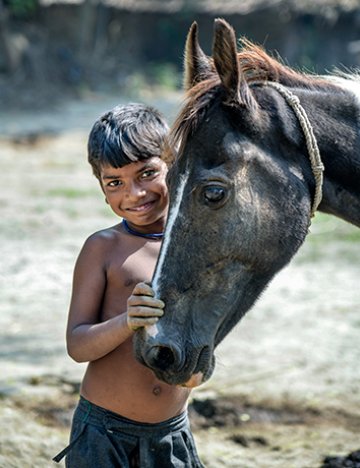
"If a horse comes to you when you walk out into the pasture, not because they expect food but because they recognise you, then it could well be that they are showing affection. If a horse picks up its head from eating to come over to where you are, your horse has just shown that you are more important than their food!" Carmella says.
"Similarly if a horse is willing to approach you on their own, without being asked, it's likely that they enjoy your presence! That’s why it’s important to always remain calm and relaxed when working with your horse.
"Horses can pick up on emotions, so if you’re always around your horse getting stressed and frustrated, they’ll negatively associate you with those emotions. If your horse is used to you being a calm and decisive leader, they will positively associate you with a happy atmosphere."
These observations are backed up by the academic studies that inform Brooke's Compassionate Handling principles. A 2010 study found that horses remembered how an individual human behaved towards them based on just one interaction, even as long as eight months later, and behaved better with handlers who used positive handling techniques, such as stroking or speaking in a soft voice.
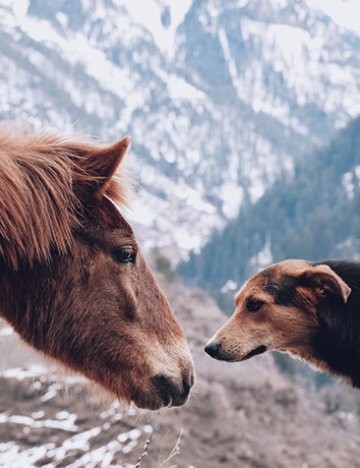
We’ve all been charmed by accounts of unusual friendships between different animals - you know the kind of thing: the cat and fox that have become inseparable, the platonic owl and orphaned giraffe relationship they said would never last, and so on. But what is behind these interspecies friendships in the case of horses, and which animals do they tend to get on with?
These companionships seem to develop when a horse spends a prolonged period without access to the company of fellow equines that would usually fill the role of playmates. The unexpected interspecies friend becomes a surrogate for equine companionship and a longterm bond often develops from there on.
Did you know the origin of the expression ‘Got Your Goat’ derives from a mutual fondness that can occur between horses and goats?
Horses and dogs and their common language of play
When it comes to horses and their interspecies friendships, dogs often seem to be high on the list of chosen playmates. This is to be expected in some ways - they are both domesticated animals that often find themselves sharing the same space. However they are quite different creatures in other ways, the most obvious one being that horses evolved as prey animals while dogs were predators.
Animal behaviorists were thus surprised to find that horses and dogs mirror each other to a remarkable extent when playing together. This playful mimicry takes many forms, for instance they might attempt to bite, but don’t actually do so; they jump, push, hit or chase each other; or they handicap themselves by rolling on their backs on the ground.
Source: National Geographic
It’s even more noteworthy given the large size difference between horses and dogs. The dog is vulnerable to injury by the horse, and the horse has a deeply ingrained tendency to fear animals who resemble wolves.
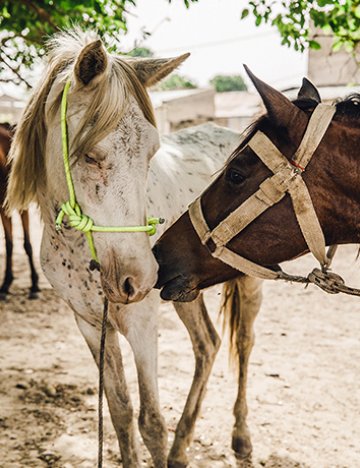
"Horses show affection and relationship towards one another by hanging out with the horses they like. Even pasture horses tend to break off into small herds of horses that get along well together and those who don’t," Carmella says.
"I have a little POA [Pony of the Americas] pony named Tucker. Tucker has a little quarter pony named Missy as his girlfriend. It’s almost as if they’re in a monogamous relationship. They have shared the same field for about three years, and they’re constantly together when out in the pasture. Missy is constantly following Tucker around. They are always together, away from the rest of the herd. So romantic!"
This account of lasting friendships between horses is backed up by academics too. Prof. George H Waring in his book Horse Behaviour writes that "it is not uncommon for mares in a group to exhibit a single best-friend relationship. They graze together, rest together, and groom together. If kept apart, the desire to rejoin a companion may persist for many months."
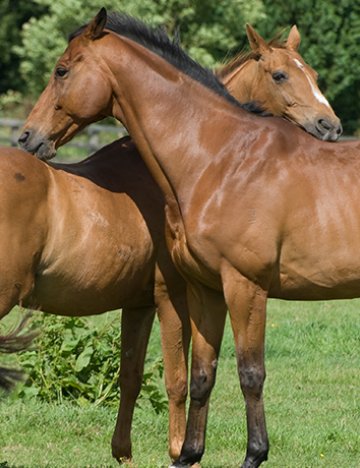
"You may have seen two horses standing with their heads at each other’s backs, using their teeth to reach each other’s scratchy patches. Grooming another horse is how your horse can show affection," Carmella says.
"When horses are young, their mother licks and grooms them. It becomes a very familiar and comforting task that represents the bond that mother and foal have. Likewise, when horses get older, they’ll do it to one another to show the same kind of fondness towards one another."
Recent studies show that 'feel good' hormones are increased in horses that undergo mutual grooming sessions, and horses also have preferred grooming partners. Mutual grooming is also associated with reduced heart rate suggesting a role in reducing anxiety (Feh and de Mazieres, 1993).
In fillys and colts this grooming can also serve as a practice run for the courtship grooming rituals that come later in life!
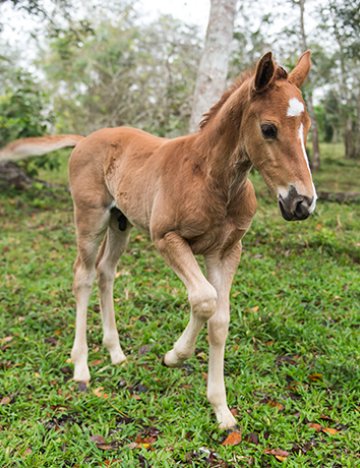
As well as acoustic clues there are some well known visual ones that you will notice when horses are happy to see their companions.
Head nodding can happen when one horse approaches another they are pleased to see - foals for example nod when eagerly approaching their mother, and stallions often nod as they approach a mare.
Do horses smile? In a manner of speaking yes - when a horse is rubbed, scratched, or groomed it will often let its pleasure be known via its upper lip, which will be extended and quivering. Not a smile as we know it, but not far off!
Eyes and ears will tell a story too: if their eyes are oriented laterally and are slightly closed, and their ears are pointed forwards or slightly relaxed to the side, it's a good sign they are happy in the company they are keeping.
And the tail? There isn't the energetic tail-wagging you will see in a dog - a relaxed horse carries their tail down. If a mare wants to show her interest in a stallion's attention however, she will let him know via some judicious tail-swishing action!
Don't forget to test your knowledge of horses and their emotions with our quiz!
Thanks to Carmella Abel from equinehelper.com who joined us with some observations from her daily interactions with her horses - thanks Carmella!
